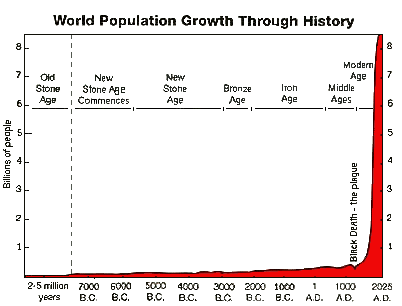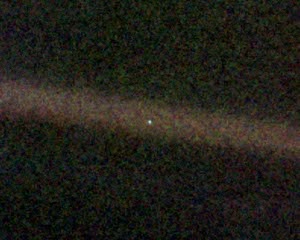 |
Most of the fundamental and dramatic changes during the more than 4 billion year history of the Earth resulted from the operation of natural geological forces, with intermittent cosmic disruptions in the form of meteor and comet collisions. Such naturally forged metamorphoses include the tectonic movements of continents and oceans, the genesis of life and the biosphere, the evolutionary development and extinction of millions of plant and animal species, and long-term shifts in climatic conditions and zones. The processes that gave rise to these transformations continue to act on the biosphere through continuing geological forces and comparatively more short-term changes in climate. The last major climatic shift (the Pleistocene-Holocene transition) inaugurated the ascent of our species as a significant presence in the Earth's biosphere.
|
|
Cultural evolution has allotted the human species progressively greater control over the Earth's environment and more complex utilization of its resources to the extent that human activities now match natural geological forces as a major agent of planetary transformation. For the past two centuries, advances in sanitation and our ability to control disease, and cheap fossil-fuel fertilizer (and miracle grains) have made possible an explosive increase in our numbers. Within the last 170 years the human population grew from about 1 billion in the 1830s to 2 billion in the 1930s, to 4 billion in 1975, and has recently surpassed 6 billion. The expansion of human populations during this period constitutes exponential growth, a process that not only characterizes our increasing numbers, but also represents our consumption of energy and resources.
 The sources of energy available to human societies have played a major part in determining the activities that they can undertake and the way in which our societies are organized. For all but the last two hundred years the sources of energy were few and the total amount of energy our ancestors could access was limited. All the forms of energy used until then were renewable (although trees, one of the most important sources, were normally treated as non-renewable). The last two hundred years have, however, been characterized by a massive and continuing increase in energy consumption of non-renewable resources. The exploitation of fossil fuels have made it possible for Homo sapiens to release, in a short time, vast amounts of energy that accumulated long before our species appeared.
 Biological species characteristically expand as much as resources allow and predators, parasites, and physical conditions permit. When a species is introduced into a new habitat with abundant resources that accumulated before its arrival, the population expands rapidly until all the resources are used up. In wine making, for example, a population of yeast cells in freshly pressed grape juice grows exponentially until nutrients are exhausted or waste products become toxic. By exploiting fossil fuel energy to modify more and more of its environment to suit human needs, the human population effectively expanded its resource base beyond immediate requirements. This has allowed a population expansion similar to that of species introduced into extremely propitious new habitats, such as rabbits in Australia or Japanese beetles in the United States. While it took 10,000 lifetimes for the human population to reach 2 billion, today, during a single human lifetime, the population may soar from 2 billion to 8 billion. Reminiscent of the manner in which a micro-organism can proliferate when introduced into the nutrient layer of a petri dish, an exponentially expanding human population has colonized the terrestrial biomes of the Earth.
Similar patterns are present in our planet's loss of forests, topsoil, groundwater stocks, wildlife species,
 stratospheric ozone, and climate stability. Most of the transformations wrought by humanity during the past 10,000 years have occurred in our lifetimes, as we've altered our environment in increasingly significant and diverse ways. Human-induced modifications to planetary processes, including biogeochemical and hydrologic cycles, are now on a scale that rivals natural changes to the Earth. stratospheric ozone, and climate stability. Most of the transformations wrought by humanity during the past 10,000 years have occurred in our lifetimes, as we've altered our environment in increasingly significant and diverse ways. Human-induced modifications to planetary processes, including biogeochemical and hydrologic cycles, are now on a scale that rivals natural changes to the Earth. |
|
|
| Jared Diamond |
 Easter Island is located over 2,000 miles from the nearest population center, making it one of the most isolated places on Earth. Viewed from above, Easter Island's surface area of only 64 square miles appears as a miniscule speck in the comparative immensity of the Pacific Ocean.
Easter Island is located over 2,000 miles from the nearest population center, making it one of the most isolated places on Earth. Viewed from above, Easter Island's surface area of only 64 square miles appears as a miniscule speck in the comparative immensity of the Pacific Ocean.
The extinction of the island’s animals was as thorough as that of the forest. Every species of native land bird went extinct; shellfish were overexploited. Porpoise bones disappeared abruptly from garbage heaps around 1500, since trees used for constructing seagoing canoes disappeared. Colonies of more than half of the seabird species breeding on the island or on its offshore islets were exterminated.
Isolated in the mid-Pacific, Easter Island exhibits various ingredients of societal collapse resulting from ecological neglect. As the descendents of the Polynesian settlers multipled unrestrained into a population numbering in the thousands, competing factions in the populous, complex society carved enormous Moai stone statues, which they erected on the seacoast far from the quarries. The forests were cut to provide logs for transporting the statues. Moai statue carving and transport intensified from 1400 to 1600 as the last stands of trees were hewn. Core sampling from the subsequent period indicates deforestation, soil depletion, and erosion leading to collapse of the island's society.
Did the islanders - recognizing their impending peril - stop quarrying, carving, and transporting Moai statues? No, and in the ensuing ecological disaster most of the island's inhabitants starved or were victims of vicious conflict. The heirs to folly on Easter Island could not escape the their fate: they lacked trees with which to construct canoes and flee into the ocean. The island population collapsed from a level of thousands to hundreds, and never recovered.
 Easter Island could presage, in miniature, problems that have started to cascade on a planetary scale as our global population grows unrestrained at the level of billions. For example:
Easter Island could presage, in miniature, problems that have started to cascade on a planetary scale as our global population grows unrestrained at the level of billions. For example:
 Following over 3.5 billion years of the evolution of life on Earth, and the advent of agricultural domestication 12,000 years ago with the subsequent rise of literate urban civilizations about 5,000 years ago, our kind - the human species - has arrived at a critical historical juncture. A planetary civilization has started to emerge. The genesis of this new civilization is one of the most significant facts of our lifetimes. What is unique to this contemporary historical condition is the change in the rate of cultural change. The evolution of the human species from its primate lineage spanned a period of millions of years. Prior periods of comparatively rapid cultural transformation - such as the European Renaissance and Industrial Revolution - spanned more than a century. But the rate of contemporary cultural change is so rapid and intense that it is happening within the extent of an individual's lifetime. Because the scale and speed of global change is now so great, many people have difficulty apprehending what is happening around them. We can recognize signs of change, and feel its impact on our lives, yet many of us now living during this era of critical change do not appreciate its full scope.
We consequently face a visionary challenge. Old forms of thinking, dogma and ideology - no matter how venerated or appropriate in the past - are dubious precedents for a successful transition to a viable planetary society. |
|
Humanity now faces the greatest challenge a neophyte technical civilization can encounter on any planet in the Universe. By increasingly impacting the biosphere of our finite, isolated planet the human species has arrived at a momentous historical decision fork. One branch of the decision fork can be characterized as Cosmic Evolution, the other branch as Planetary Senescence.

But what of the alternate branch, Planetary Senescence?
The alternative possibilities for future human (and planetary) progression - Cosmic Evolution and Planetary Senescence - can be epitomized by analogy.
We have virtually and simultaneously gained the ability to unlock the secrets of our Universe, as well as to self-destruct. Given a choice, Cosmic Evolution may be our most appropriate and desirable future. But given the facts, Planetary Senescence may be our eventual fate. |